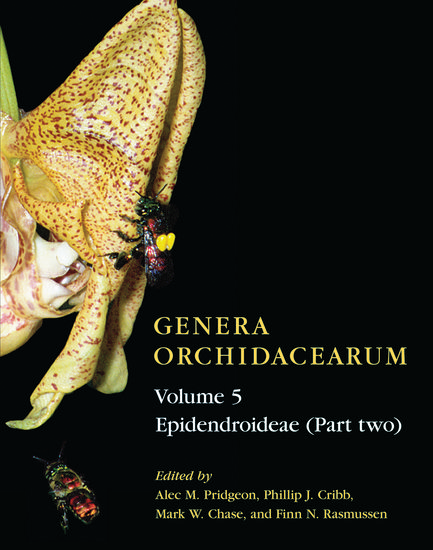By Alec Pridgeon
“Blasphemy”! That was the only remark that anyone heard from the woman after she stormed out of the orchid society meeting in Florida. Taken aback for a moment, the speaker continued his talk on orchid evolution to an otherwise appreciative audience.
 In the course of the last 13 years, five of the six volumes of Genera Orchidacearum have been published. It has been a massive project to monograph the approximately 800 orchid genera established on a firm phylogenetic foundation, each generic treatment including the description and distribution, and what is known about its anatomy, palynology, cytogenetics, phytochemistry, phylogenetics, ecology, pollination, uses, and cultivation. Driving the classification is a heavy reliance on available DNA sequences from multiple genes and gene regions, which have laid bare true relationships beneath many millennia of mainly floral convergences in response to pollinator pressures, as well as many centuries of artificial keys in floras and monographs that used such floral characters to define the genera.
In the course of the last 13 years, five of the six volumes of Genera Orchidacearum have been published. It has been a massive project to monograph the approximately 800 orchid genera established on a firm phylogenetic foundation, each generic treatment including the description and distribution, and what is known about its anatomy, palynology, cytogenetics, phytochemistry, phylogenetics, ecology, pollination, uses, and cultivation. Driving the classification is a heavy reliance on available DNA sequences from multiple genes and gene regions, which have laid bare true relationships beneath many millennia of mainly floral convergences in response to pollinator pressures, as well as many centuries of artificial keys in floras and monographs that used such floral characters to define the genera.
Without these evolutionary studies, we would not be able to answer questions that have plagued orchid scientists for years. Citing only a few examples, we now know that:
- The Orchidaceae is one of the oldest flowering plant families, dating from the Late Cretaceous, some 76-84 million years ago when Tyrannosaurus shook the earth. Reminiscent of Jurassic Park, the answer ultimately came from the discovery of pollen masses of an orchid stuck to the back of a bee. What made this situation unique was that the bee was embedded in amber and so could be dated with some degree of accuracy. Prior to this, the long-standing conventional wisdom was that the orchid family was a relative newcomer to the evolutionary scene.
- Vanilla is one of the oldest orchid genera, which helps to explain its pantropical distribution with the exception of Australia.
- The first orchids were terrestrials, not epiphytes, as some have claimed.
Just as important, evolution is consistent with data from other scientific disciplines such as geology and provides a robust, genetic, predictive framework on which to base other scientific studies of all types in the future.
Dr. Alec M. Pridgeon is presently Sainsbury Orchid Fellow at the Royal Botanic Gardens, Kew, where he specializes in molecular phylogenetics and co-edits and contributes to Genera Orchidacearum, a comprehensive multi-volume monograph of the orchid family. He has written or co-written more than 50 scientific articles or book chapters and more than 100 popular articles, edited 14 books including the Proceedings of the 14th World Orchid Conference and The Illustrated Encyclopedia of Orchids, and compiled the Orchid Action Plan for the Species Survival Commission of the IUCN in Geneva. In 2011 he was elected Chairman of the International Orchid Committee.
Subscribe to the OUPblog via email or RSS.
Subscribe to only environmental and life sciences articles on the OUPblog via email or RSS.
View more about this book on the ![]()
![]()




[…] The evolution of orchids (oup.com) […]